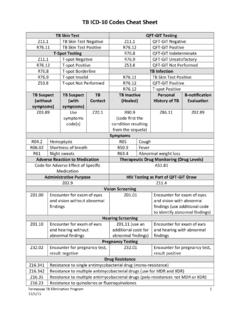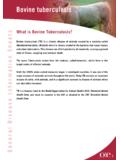Transcription of TB Elimination. The Difference Between Latent TB Infection ...
1 CS227840_F(Page 1 of 2)TB EliminationThe Difference Between Latent TB Infection and TB DiseaseNational Center for HIV/AIDS, Viral Hepatitis, STD, and TB Prevention Division of Tuberculosis EliminationWhat is TB?Tuberculosis (TB) is a disease caused by a germ called Mycobacterium tuberculosis that is spread from person to person through the air. TB usually affects the lungs, but it can also affect other parts of the body, such as the brain, the kidneys, or the spine. When a person with infectious TB coughs or sneezes, droplet nuclei containing M. tuberculosis are expelled into the air. If another person inhales air containing these droplet nuclei, he or she may become infected. However, not everyone infected with TB bacteria becomes sick. As a result, two TB-related conditions exist: Latent TB Infection and TB is Latent TB Infection ?
2 Persons with Latent TB Infection do not feel sick and do not have any symptoms. They are infected with M. tuberculosis, but do not have TB disease. The only sign of TB Infection is a positive reaction to the tuberculin skin test or TB blood test. Persons with Latent TB Infection are not infectious and cannot spread TB Infection to , without treatment, about 5 to 10% of infected persons will develop TB disease at some time in their lives. About half of those people who develop TB disease will do so within the first two years of Infection . For persons whose immune systems are weak, especially those with HIV Infection , the risk of developing TB disease is considerably higher than for persons with normal immune special concern are persons infected by someone with extensively drug-resistant TB (XDR TB) who later develop TB disease; these persons will have XDR TB, not regular TB person with Latent TB Infection Usually has a skin test or blood test result indicating TB Infection Has a normal chest x-ray and a negative sputum test Has TB bacteria in his/her body that are alive, but inactive Does not feel sick Cannot spread TB bacteria to others Needs treatment for Latent TB Infection to prevent TB disease.
3 However, if exposed and infected by a person with multidrug-resistant TB (MDR TB) or extensively drug-resistant TB (XDR TB), preventive treatment may not be an option What is TB Disease?In some people, TB bacteria overcome the defenses of the immune system and begin to multiply, resulting in the progression from Latent TB Infection to TB disease. Some people develop TB disease soon after Infection , while others develop TB disease later when their immune system becomes general symptoms of TB disease include Unexplained weight loss Loss of appetite Night sweats Fever Fatigue Chills The symptoms of TB of the lungs include Coughing for 3 weeks or longer Hemoptysis (coughing up blood) Chest pain Other symptoms depend on the part of the body that is with TB disease are considered infectious and may spread TB bacteria to others.
4 If TB disease is suspected, persons should be referred for a complete medical evaluation. If it is determined that a person has TB disease, therapy is given to treat it. TB disease is a serious condition and can lead to death if not person with TB disease Usually has a skin test or blood test result indicating TB Infection May have an abnormal chest x-ray, or positive sputum smear or culture Has active TB bacteria in his/her body Usually feels sick and may have symptoms such as coughing, fever, and weight loss May spread TB bacteria to others Needs treatment to treat TB disease Additional Information1. American Thoracic Society (ATS) and CDC. Diagnostic standards and classification of tuberculosis in adults and children. (PDF) Am J Respir Crit Care Med 2000; 161. CDC.
5 Questions and Answers About TB. CDC. Multidrug-Resistant Tuberculosis (MDR TB). CDC. Extensively Drug-Resistant Tuberculosis (XDR TB). 2011















